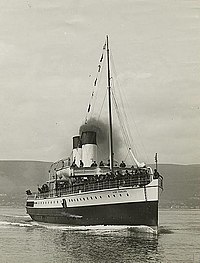TS King Edward

TS King Edward on trials, 1901
|
|
| History | |
|---|---|
| Name: | TSS King Edward |
| Owner: |
|
| Operator: | (owner) |
| Port of registry: | |
| Builder: | William Denny and Brothers, Dumbarton |
| Yard number: | 651 |
| Launched: | 16 May 1901 |
| Out of service: | 1952 |
| Fate: | Scrapped |
| General characteristics | |
| Tonnage: | 502 gross register tons (GRT) |
| Length: | 250.5 ft (76.4 m) |
| Beam: | 30.1 ft (9.2 m) |
| Propulsion: | Steam Turbine; triple screw, later single screw |
TS King Edward was an excursion steamer built at Dumbarton for service down the River Clyde to the Firth of Clyde and associated sea lochs on the west coast of Scotland, as far as Campbeltown. The first commercial vessel to be driven by steam turbines, King Edward was remarkably successful for a prototype, serving as a Clyde steamer for half a century from 1901 until 1951, interrupted only by service in the two world wars. The success of the vessel quickly led to the adoption of turbine propulsion for all manner of merchant vessels, from channel ferries and coastal steamers to transatlantic liners.
In 1803, Charlotte Dundas showed the practicality of steam power for marine use, and in 1812 Henry Bell's PS Comet began the first commercially successful steamboat service in Europe, sailing on the River Clyde between Glasgow and Helensburgh. Others soon followed, and by mid century a large fleet of Clyde steamers competed for holiday and excursion traffic down the River and Firth of Clyde. By the end of the century paddle steamers had reached a peak of design, with a maximum economic operating speed of around 19 knots (35 km/h), but speed was at a premium, particularly on the longer routes such as sailings from Glasgow to Inveraray and Campbeltown. Up to this time, vessels had been powered by reciprocating steam engines. Steam was generated by boilers, and piped to cylinders wherein it drove pistons, the back-and-forth motion of which was converted to rotary motion by connecting rods. Early vessels were driven by paddle wheels, but at mid-century screws became more prevalent. Although increased boiler pressures and the reuse of partially expanded steam in compound engines greatly increased efficiency, the continual creation and destruction of momentum of their heavy reciprocating parts each turn of the crankshaft put great strain on the engines, which required constant maintenance.
...
Wikipedia
